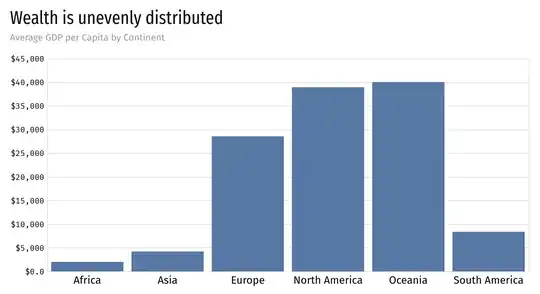The following bar chart is one of the most commonly drawn, and yet I cannot find any dedicated name for it. It uses a categorical independent variable (dimension) for the horizontal axis and a numerical dependent variable (measure) for the vertical axis. The numerical dependent variable is the result of an aggregation like a sum or average (like in the following example).
Some people mistakenly call this a histogram, but it is not one, for a histogram is an estimate of the probability distribution of a continuous variable (Source: Wikipedia), and there is no continuous variable to which the categorical dimension used for the horizontal axis can be associated.
This chart is closely related to a frequency chart, but it is not one in most instances (like this one), for the vertical axis does not always visualize a frequency, it visualizes an arbitrary aggregation. Of course, this aggregation could be a count, in which case we would have a proper frequency chart indeed, but it could also be a sum, an average (as is the case in the chart above), a median, or any other summary statistic.
For that reason, I like to call it a summary chart, but I wonder if there is a more established name that I could use instead. And it goes without saying that bar chart is not a valid candidate, for it is not specific enough: histograms and frequency charts are all specific types of bar charts (in my opinion), or look way too much like one (if you believe that a histogram is not a specific type of bar chart).
Bar plot would be a last resort option, but there is no well-accepted delineation between chart and plot. For most people, these two terms are synonyms. Furthermore, I tend to believe that plot should be reserved for visualizations depicting independent observations (raw data) instead of the results of aggregations, but this is a rather personal preference. For example, the following bar plot depicts the height of the tallest building within each country, and this visual is produced from a list of countries with Name and Tallest Building Height as variables, instead of a list of buildings with Country and Building Height as variables. A similar visual could have been produced for the latter dataset using a MAX aggregation, and this visual would be called a summary chart. But because the following visual is not the result of any aggregation (as far as the source dataset is concerned), it is not a summary chart, and while it is a bar chart, I call it a bar plot to be more specific.
Bar graph shares the same problems as bar plot, and I tend to avoid using the term graph for visualization, for it could create confusion with the field of graph theory. Trained statisticians know how to make the difference, but your casual user might get confused, and I treat this casual user as my primary audience for this terminology.
Column chart is not a desirable candidate either, because it is a synonym for vertical bar chart, and it does not convey any statistical meaning, unlike summary chart.
Why do we need a name for that chart? So that we can distinguish it from other charts that look similar but are different (histogram or frequency chart for example). Does it mean that we will need different names for different aggregations? Probably not, because summary chart is clear enough.
But will that make the term frequency chart redundant then, since it would refer to a particular type of summary chart for a particular summary statistic? No, because the frequency chart is a very particular (and important) summary chart, since it is using a very specific type of aggregation (count) that can be used with a single categorical variable, unlike sum or average for example, which require both a categorical variable (the dimension) and a numerical variable (the measure).
To summarize, in my proposed terminology:
- A summary chart is a particular type of bar chart.
- A frequency chart is a particular type of summary charts.
- Most summary charts are not frequency charts (they visualize aggregations other than count).
- A histogram is a particular type of bar chart.
- A summary chart is not a histogram.
- A histogram is not a summary chart.
- A summary chart is called that way because it visualizes a summary statistic.
- Not all charts visualize summaries on data (scatter plots do not for example).
- Many charts visualize summaries on data but have nothing to do with a summary chart.
- Terminology matters, and I do not think that I have to explain why.

